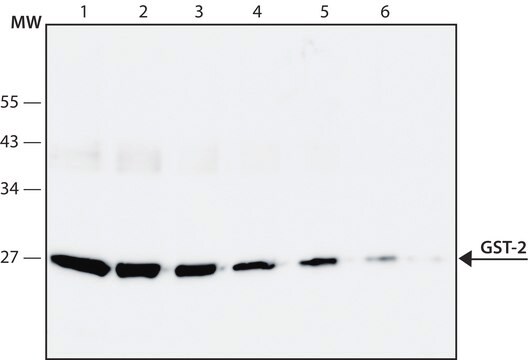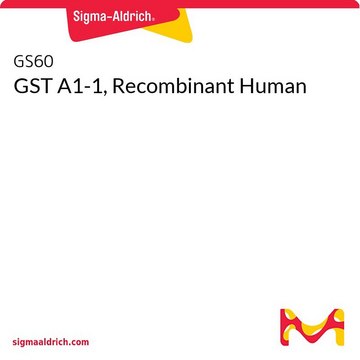CS0410
Glutathione-S-Transferase (GST) Assay Kit
sufficient for 500 multiwell tests
Sinónimos:
GST Enzyme Activity Kit
About This Item
Productos recomendados
uso
sufficient for 500 multiwell tests
Nivel de calidad
Condiciones de envío
dry ice
temp. de almacenamiento
−20°C
Información sobre el gen
human ... GSTA4(2941) , GSTM1(2944)
Descripción general
and erythrocyte lysates
Aplicación
Acciones bioquímicas o fisiológicas
Solo componentes del kit
- Dulbecco's Phosphate Buffered Saline 100 mL
- L-Glutathione Reduced 1 g
- GST (Control) .1 mL
- Sample Buffer 5 mL
- Substrate (CDNB) 1.2 mL
Palabra de señalización
Danger
Frases de peligro
Consejos de prudencia
Clasificaciones de peligro
Acute Tox. 2 Dermal - Acute Tox. 4 Oral - Aquatic Acute 1 - Aquatic Chronic 1 - Eye Dam. 1 - Skin Irrit. 2 - Skin Sens. 1
Código de clase de almacenamiento
6.1A - Combustible acute toxic Cat. 1 and 2 / very toxic hazardous materials
Punto de inflamabilidad (°F)
Not applicable
Punto de inflamabilidad (°C)
Not applicable
Certificados de análisis (COA)
Busque Certificados de análisis (COA) introduciendo el número de lote del producto. Los números de lote se encuentran en la etiqueta del producto después de las palabras «Lot» o «Batch»
¿Ya tiene este producto?
Encuentre la documentación para los productos que ha comprado recientemente en la Biblioteca de documentos.
Los clientes también vieron
Nuestro equipo de científicos tiene experiencia en todas las áreas de investigación: Ciencias de la vida, Ciencia de los materiales, Síntesis química, Cromatografía, Analítica y muchas otras.
Póngase en contacto con el Servicio técnico









